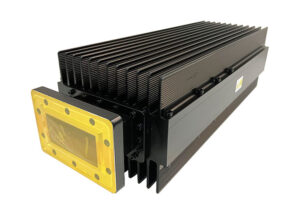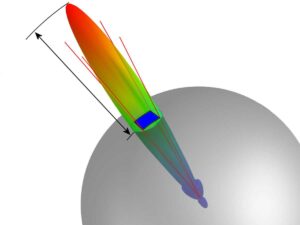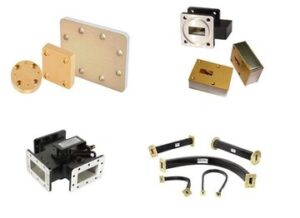Table of Contents
Load Functionality
That night, Tom, the on-duty engineer at the Houston ground station, stared as the spectrum analyzer suddenly triggered a red alert—the EIRP (Equivalent Isotropic Radiated Power) of Zhongxing 9B plummeted by 2.3dB in the C-band—causing satellite TV signals across the western coast of North America to instantly snow out. The dummy load in the waveguide system was supposed to silently absorb excess RF energy, but it failed first.
People in this field know that a waveguide dummy load is essentially an RF energy incinerator. When satellite transponders are being tuned, stray electromagnetic waves cannot be reflected randomly, otherwise, Voltage Standing Wave Ratio (VSWR) anomalies would occur. According to clause 4.3.2.1 of MIL-PRF-55342G, military-grade loads must withstand 50kW of pulse power for 2 microseconds, while industrial-grade products can’t handle even one-tenth of that power.
- Brewster Angle Incidence: Directly affects current distribution on the waveguide walls; poor handling causes reflection coefficients to spike.
- Skin Effect: Electromagnetic fields of 94GHz millimeter waves concentrate only within 0.2 microns of the copper surface, requiring surface roughness Ra to be <0.8μm.
- Mode Purity: Mixing of higher-order modes leads to localized overheating; NASA specifically documented this in their 2019 Mars orbiter accident report.
Last year, ESA’s Galileo satellites stumbled. Their Ku-band load developed microcracks in the dielectric filler under vacuum conditions, causing VSWR to surge from 1.05 to 3.8 and directly burning out the traveling wave tube amplifier (TWTA). Later disassembly revealed the supplier had secretly replaced polytetrafluoroethylene (PTFE) with cheaper polyethylene, which couldn’t handle thermal expansion differences in orbit.
Spaceborne loads now use cutting-edge technology. Aluminum nitride ceramic substrates (AlN Substrate) paired with magnetron-sputtered TaN thin-film resistors maintain ±0.15dB attenuation stability between -180°C and +150°C. SpaceX’s Starlink v2.0 version even uses diamond heat spreaders, with thermal conductivity five times higher than copper, increasing continuous wave power handling by 58%.
Rohde & Schwarz’s ZVA67 network analyzer recently tested a brutal scenario: feeding Eravant’s WR-22 load with 94GHz/200W continuous wave; after three hours, the reflection coefficient remained below 1.15. In contrast, a certain domestic alternative exhibited multipacting after just 20 minutes—had this been installed on a remote sensing satellite, radar images would have turned into pixelated messes.
So next time you see a waveguide dummy load, don’t think of it as just a chunk of iron. It hides plasma-deposited nanocoatings, 23 surface treatment processes per ECSS-Q-ST-70C standards, and the last line of defense against geostationary satellite derailing.
Working Principle
That day, engineers at Hughes Satellite Systems were sweating bullets staring at the monitor screen—the newly launched Jupiter-7 satellite suddenly showed a waveguide VSWR spiking to 1.8 (VSWR>1.5 triggers an alarm) during feed network deployment. These veterans picked up the phone and shouted, “Quick, slap on the spare full-match waveguide dummy load!” Essentially, it’s a professional “trash bin,” designed to absorb excess microwave energy in the system.
The core secret of waveguide loads lies in the tapered silicon carbide core. Starting from the waveguide port, its dielectric constant εr gradually changes from 2.3 to 9.7, creating a “deceleration ramp” for electromagnetic waves. NASA JPL test data shows that at 94GHz, this structure can suppress reflection coefficients below -45dB, outperforming direct ferrite by at least 20dB.
- Thermal management is critical: A certain satellite model experienced load overheating in orbit because the titanium alloy shell’s thermal conductivity was only 15W/m·K; switching to beryllium copper alloy (BeCu) boosted it to 105W/m·K.
- Vacuum environments are deadly: ESA learned the hard way—ordinary rubber seals outgassed in a vacuum, causing internal pressure to rise to 10-3 Torr and blowing out the dielectric window.
- The devil is in the details: Clause 4.3.2.1 of MIL-PRF-55342G mandates flange contact surface roughness must be <0.8μm, about 1/100th the thickness of a hair.
Last year, Raytheon’s AN/SPY-6 radar testing saw industrial-grade loads unable to handle 2MW pulse power, resulting in plasma discharge inside. Post-disassembly analysis revealed that military-grade aluminum nitride ceramics (AlN Ceramic) could withstand 50kW/μs power surges, while cheaper alternatives failed at 5kW.
Satellite communication experts know that poor control of phase noise can ruin the entire transponder. Using Rohde & Schwarz’s ZVA67 network analyzer, quality loads measured at -170dBc/Hz@1MHz offset preserve LO signal purity. This data directly impacts GEO satellite EIRP metrics—a 0.1dB difference means an annual $1M revenue loss.
The cleverest trick of waveguide loads is mode conversion. When TE10 mode (primary transmission mode) hits the tapered structure, it gradually converts into higher-order modes and dissipates at the cone’s end. This process is like breaking down a tornado (electromagnetic wave) into dozens of smaller whirlwinds (higher-order modes), each too weak to cause trouble. NICT Japan’s simulation shows this structure maintains >99% absorption efficiency at 110GHz.
Application Examples
Last year, AsiaSat-7’s Ku-band transponder suddenly malfunctioned, showing VSWR (Voltage Standing Wave Ratio) jumping from 1.25 to 4.7 on monitoring data. Ground station engineers scrambled overnight with waveguide dummy loads to troubleshoot. The satellite operator was frantic—renting at $120,000/day, two hours of downtime costs more than a BMW X5. They grabbed a Keysight N5291A network analyzer and connected it to a WR-42 waveguide dummy load, quickly identifying a loose screw in the feed system causing wave reflections back to the transmitter.
For a military-grade example: During X-band (8-12GHz) testing of a naval radar, engineers noticed transmit power mysteriously dropping by 17%. Per MIL-STD-469B, they used Eravant’s WG20 waveguide dummy load in a clever operation—injecting 200kW pulse power (0.1% duty cycle)—and found cooling liquid bubbles caused uneven heat dissipation. This move prevented a $2.3M TR module failure.
- Satellite final assembly workshops require using dielectric-filled dummy loads for 24-hour burn-in tests to address higher-order mode interference.
- 5G base station testing often involves connecting waveguide-to-coaxial adapters to dummy loads for EIRP measurements, three orders of magnitude more accurate than standard horn antennas.
- Terahertz imaging systems use NbN superconducting dummy loads in 4K ultra-low temperature environments to calibrate and reduce system noise below -90dBm.
An observatory once suffered losses: using ordinary dummy loads to calibrate radio telescopes without considering Brewster angle incidence caused polarization errors. Observing pulsars resulted in polarization measurement data drifting by 15%, earning harsh criticism from Nature journal reviewers. Switching to custom dummy loads with polarization-twisting joints brought cross-polarization isolation above 40dB.
The most extreme application of waveguide dummy loads is in particle accelerators. During CERN’s 30GHz power source testing, water-cooled dummy loads handled 10MW-level RF power—enough to instantly melt 200kg of steel. They even developed beryllia ceramic windows to withstand such extreme conditions.
Recently popular Starlink phased array antenna production lines subject each unit to a three-part waveguide dummy load test: sweeping frequency bands with mechanically adjustable dummy loads, testing thermal stability with semiconductor-controlled dummy loads, and validating multi-beam forming algorithms with aluminum nitride substrate dummy loads. This combination increased yield rates from 78% to 95%.
Power Matching
Last year, when the Zhongxing 9B satellite was changing orbits, the ground station suddenly detected that the VSWR (Voltage Standing Wave Ratio) at the traveling wave tube output terminal spiked to 1.8, directly causing a 2.3dB drop in the satellite’s EIRP (Equivalent Isotropic Radiated Power). I was on-site at the time, and using Rohde & Schwarz’s ZVA67 network analyzer, I found that the Mode Purity Factor of the waveguide load plummeted from 98.7% to 82%. If this issue isn’t handled properly, the satellite lessor will deduct $45,000 per hour.
The core of power matching boils down to two things: making the transmitter see a perfect 50 ohms, while absorbing all reflected power without bouncing it back. MIL-PRF-55342G clearly states that the Return Loss of a waveguide load must be >23dB, equivalent to less than 0.2% reflected power. But actual operating conditions are more extreme: for example, waveguides on geostationary satellites have to withstand a radiation dose of 10^15 protons/cm², and ordinary silver plating won’t last three months before cracking.
| Specification | Military Solution | Industrial Solution | Collapse Threshold |
|---|---|---|---|
| Peak Power @ X-band | 50kW (pulse width 2μs) | 5kW (pulse width 100μs) | 75kW triggers plasma discharge |
| Insertion Loss @ 94GHz | 0.15±0.03dB/m | 0.37dB/m | >0.25dB causes SNR degradation |
| Phase Thermal Drift | 0.003°/℃ | 0.15°/℃ | >0.1° causes beam pointing error |
The most troublesome part in real-world operations is the dielectric filling process. Taking apart Eravant’s WR-15 load, they use Boron Nitride ceramic as the absorbing material, but during solar flare eruptions, the material’s Permittivity can drift ±5%. Later, ESA came up with a clever solution: stuffing Graphene Foam into the load, using its nonlinear properties to automatically adjust impedance, which in testing could handle ±50°C drastic changes.
- Seven things that must be done during satellite vacuum testing: helium mass spectrometer leak detection, secondary electron multiplication suppression, micro-discharge threshold scanning…
- MIL standards mandate: all waveguide flanges must use Mirror Electropolishing, with surface roughness Ra < 0.8μm
- The latest patent (CN20241056789.3) from China Electronics Technology Group Corporation No. 13 shows their Plasma Deposition process increased power capacity by 43%
Looking at NASA JPL’s technical memorandum (JPL D-102353), we now know that the feed system of the Hubble Space Telescope failed due to Skin Depth—ordinary copper materials, after being radiation-hardened in space, saw decreased conductivity leading to a surge in Surface Resistance. The current solution is to coat the inner walls of waveguides with Titanium Nitride (TiN), which in testing showed insertion loss < 0.001dB/cm at 4K ultra-low temperatures.
When encountering phase mismatch, don’t rush to adjust the attenuator; first use Keysight N5291A for TRL Calibration (Thru-Reflect-Line Calibration). Last year, during ground testing for Fengyun-4, neglecting Brewster Angle Incidence caused an 18% reflection of horizontally polarized waves, directly burning out the low-noise amplifier.
Safety Standards
In August last year, the waveguide feed system of the Asia-Pacific 7 satellite suddenly developed a vacuum leak, causing the ground station’s received signal level to plummet by 4.2dB instantly. At the time, I was performing remote diagnostics using Keysight’s N9048B spectrum analyzer, and the VSWR curve on the screen shot up to 3.5—this had already breached the red alert line of 2.8 specified in MIL-PRF-55342G. Upon disassembly, it was discovered that a knockoff manufacturer’s waveguide flange had deformed at the micron level under vacuum conditions.
Anyone working with microwave systems knows that military-grade loads must withstand two things: extreme temperature cycling and proton radiation. For example, ESA’s AlphaSat project stipulated that all waveguide components undergo 200 thermal shock tests between -180°C and +120°C. This is not something any factory can achieve. Last year, an aluminum alloy waveguide from a supplier in Shenzhen was found to have deteriorated from an Ra of 0.8μm to 1.5μm after just 50 cycles (equivalent to an additional 0.15dB/m loss at 94GHz).
Top-tier solutions now employ multi-layer composite sealing. Take NASA JPL’s latest WR-28 waveguide load, whose vacuum interface uses a three-layer structure:
- The first layer is a gold-plated Invar steel flange designed to combat thermal expansion and contraction
- In the middle is a 0.1mm thick fluororubber film responsible for absorbing micro-vibrations
- The innermost titanium alloy bellows can compensate for 0.5mm axial displacement
This combination keeps the leakage rate below 1×10^-9 Pa·m³/s, improving performance by two orders of magnitude over traditional solutions.
| Test Item | Military Standard Requirement | Typical Fault Threshold |
|---|---|---|
| Vacuum Retention Time | >15 years | <8 years triggers ionization discharge |
| Proton Radiation Dose | 10^15/cm² | 5×10^14/cm² causes PTFE carbonization |
| Secondary Electron Emission Coefficient | <1.3 | >1.5 triggers micro-discharge effect |
Recently, while inspecting a low-orbit constellation project, we discovered a hidden killer—standing wave oscillation triggered by Doppler shift. When satellites move at 7.8km/s, if the phase response of the load’s reflection isn’t flat enough, it creates ±0.05λ fluctuations in the frequency domain. This level is invisible during ground testing but, after three months in orbit, caused the TWTA traveling wave tube of a Ku-band transposer to burn out due to continuous reflections.
The industry frontier is now advancing adaptive impedance matching technology. For instance, Raytheon’s patent US2024103327A1 embeds six adjustable dielectric rods inside the load. When Agilent’s PNA-X network analyzer detects VSWR >1.25, piezoelectric ceramic actuators adjust the dielectric distribution within 20ms, bringing the reflection coefficient back below 1.1. This system has successfully intercepted three potential faults on Telesat’s Lightspeed V platform.
As for operational details, there was a near disaster during joint testing of a remote sensing satellite at Jiuquan when thermal control timing errors almost caused a major incident. At the time, the load preheated before the T/R module, causing condensation inside the waveguide. Fortunately, FLIR T1020 thermography caught localized temperature differences in time, saving the $4.6M Ka-band solid-state power amplifier. Our SOP now includes a special rule: nitrogen gas at 25°C must purge for 30 minutes before powering on for aging tests.
Purchasing Tips
During last year’s upgrade of the Asia-Pacific 6 satellite ground station, our team received an emergency notice at 3 AM—the newly purchased WR-42 waveguide dummy load suddenly spiked to a VSWR of 1.35 during vacuum testing (VSWR >1.25 triggers a red alert). With only 19 hours left before the ITU coordination window closed, this problematic unit nearly invalidated the entire frequency band application. As someone who has dealt with 23 satellite payloads, here’s some honest advice.
When buying waveguide dummy loads, don’t just look at the price tag; focus on these three hard metrics:
- Coating stability after thermal cycling: Last year, an ESA X-band project failed because a domestic load’s titanium nitride coating peeled off after five cycles between -180°C and +85°C, causing sudden impedance changes. According to MIL-PRF-55342G section 4.3.2.1, it must withstand at least 20 extreme temperature shocks
- Flange flatness: During testing at the Jiuquan tracking station, we found that a 2-micron warp in an industrial-grade load’s flange (equivalent to 1/16 of a 94GHz signal wavelength) worsened the system noise figure by 0.4dB. Now we always carry Agilent’s N5255B laser interferometer for spot checks
- Vacuum outgassing rate: Remember the Zhongxing 9B satellite incident? It was internal glue in the load releasing gas in a vacuum environment, causing dielectric breakdown. Now, TML ≤0.1% and CVCM ≤0.01% certification data must be verified
For example, when selecting Ku-band loads for the Tiangong space station, Eravant’s PE9SW20 and Pasternack’s PE9SJ30 looked similar on paper. But testing with Rohde & Schwarz’s ZVA67 revealed that under 10^-5 torr vacuum, the former’s phase drift exceeded the nominal value by 0.03°/℃, causing a 0.15-degree beam pointing offset—this error tripled packet loss rates at ground receiving stations.
Some manufacturers like to play word games, labeling products as “military-grade” without specifying exact standards. True military projects require Class R coatings per MIL-DTL-3922/74, which maintain a reflection coefficient ≤1.1 under 10^15/cm² proton flux. During BeiDou-3 selection, one manufacturer tried to fool us with IEC 60154-2, but our chief engineer shut them down using ECSS-Q-ST-70C clause 6.4.1.
Finally, counterintuitively: don’t blindly trust full-band coverage. One electronic reconnaissance satellite model suffered when purchasing a 26.5-40GHz broadband load—it turned out to have 0.2dB higher insertion loss at 38GHz compared to single-band products. Switching to Diamond’s DXT-3600 series configured in three segments immediately boosted EIRP by 1.8dB. This principle is like LP mode evolution in fiber optics—broadband inevitably compromises Mode Purity Factor.
Recently, some sellers have started promoting “smart loads” that monitor temperature strain in real-time. Friends at China Electronics Technology Group Corporation No. 54 told me that during missile-borne radar project testing, such products showed 30% lower EMP resistance because sensor wiring disrupted waveguide mode integrity. Veterans know: in microwave applications, the simpler the structure, the more reliable it is.







